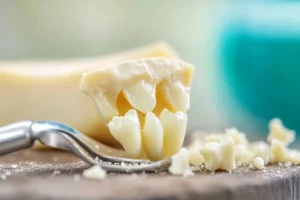It is a versatile and flavorful cheese, perfect for many dishes. This article explores its origins, taste, uses, and more.
What is Gruyere Cheese?
Gruyere cheese is a hard, yellow Swiss cheese. It is named after the town of Gruyères in Switzerland. Moreover, it is known for its complex, nutty flavor. Gruyere cheese is also very popular in French cooking. It adds a unique taste and texture to various recipes. Therefore, many chefs love using it. It is made from cow’s milk. The cheese is aged for several months. This process develops its signature taste.
A Journey Through Time: The Origins of Gruyere
The history of gruyere cheese dates back centuries. The cheese was first made in the Swiss Alps. Consequently, farmers used their cow’s milk to create it. The making process was refined over time. As a result, gruyere cheese became known for its high quality. It’s a traditional cheese with a long history. In addition, it has become a beloved choice globally. Many cultures appreciate its unique character. Gruyere’s production also relies on specific techniques and traditions passed down through generations. These methods contribute to the cheese’s consistent quality and distinct taste. Therefore, it holds a special place in culinary history.
Gruyere’s Unique Flavor Profile
The taste of gruyere cheese is complex. It has a nutty, slightly salty flavor. It also has a hint of earthiness. Furthermore, the taste can change as it ages. A younger gruyere cheese will taste more mild. However, aged gruyere will taste more intense. Its flavor is truly one of a kind. Thus, it is used in many gourmet recipes. The aging process directly affects its taste. This process allows the flavors to develop fully. Gruyere cheese is a delight to the palate due to its complex and evolving flavors.
Gruyere in the Kitchen
It is incredibly versatile. It works well in many kinds of dishes. You can use it in baking, cooking, and even snacks. Indeed, it adds a wonderful taste to any meal. Therefore, it’s a kitchen staple for many. Its melting properties are ideal for many dishes. It can be a star in a recipe or a complementary flavor. Gruyere cheese has a place in almost every cuisine.
Classic Gruyere Recipes
There are many classic recipes that feature gruyere cheese. For example, French onion soup is a popular dish. Gruyere is often melted on top. Likewise, quiches and gratins benefit from its flavor. In addition, gruyere can add richness to fondue. These dishes showcase its melting properties. The classic dishes often highlight the cheese’s natural flavors. Gruyere plays a crucial role in each of these recipes. It adds depth and richness.
Using Gruyere in Everyday Meals
Gruyere cheese is not just for special dishes. You can also use it in everyday meals. For example, try it in sandwiches or paninis. It also tastes great on pizza. Additionally, you can add shredded gruyere to salads. Its unique taste can enhance your daily meals. Gruyere cheese is an easy way to add flavor. It can make a simple meal much more enjoyable. Therefore, you can easily include it in your daily cooking.
Pairing Gruyere with Other Ingredients
Gruyere cheese pairs well with many foods. Therefore, it is perfect for many kinds of meals. For example, it tastes amazing with ham. Moreover, it is great with fruits such as apples. It also goes nicely with nuts. Gruyere’s flavor enhances the taste of many ingredients. Its versatility makes it a great cheese to have in your kitchen. It’s easy to combine with both savory and sweet flavors. Hence, it can work in many kinds of dishes.
The Nutritional Value
Although it’s tasty, gruyere cheese also provides some nutrients. It has calcium and protein. However, it is also high in fat. Therefore, you need to consume it in moderation. Balance is important for a healthy diet. It’s important to understand both its benefits and potential downsides. This will allow you to enjoy it responsibly.
Understanding the Macronutrients
Gruyere cheese, like other cheeses, is rich in fats. It also contains protein. In addition, there is some amount of carbohydrates. However, these are present in very small amounts. Understanding these nutrients helps with moderation. This helps you to enjoy it as part of a balanced eating pattern. Knowing the quantities of each nutrient is essential. It will help you to incorporate it healthily into your meals.
Key Vitamins and Minerals in Gruyere
Gruyere cheese provides some valuable nutrients. It contains calcium, which is good for bones. Furthermore, it offers a small amount of vitamin A. It also contains some B vitamins. These vitamins and minerals contribute to your well-being. However, gruyere should still be eaten in moderation. While it contains several nutrients, it should not be considered a primary source. These nutrients support bodily functions. However, variety is also key.
Dietary Considerations for Gruyere
Gruyere cheese is not a low-fat choice. Therefore, people watching their fat should consider portions. It is important to include it as a treat. Additionally, it is not suitable for people with milk issues. Understanding your dietary needs is crucial. Indeed, this will guide your food choices. Those with concerns should always check with a doctor. This will ensure that gruyere cheese fits with your diet.
Buying and Storing Gruyere Cheese
Knowing how to buy and store gruyere cheese is important. It helps keep its taste and texture optimal. Consequently, it will last longer. Also, proper storage means you get the most out of it. Taking care of your cheese is part of the full experience. It helps you enjoy the flavor and texture as intended.
Choosing the Right Gruyere
When buying gruyere cheese, look for a good texture. The cheese should be firm. Also, it should have a rich yellow color. Furthermore, check the aging. This affects the flavor. Gruyere is often sold in blocks. It can also be found grated. These are all things to keep in mind. The appearance is a good indicator of the cheese’s quality. Also, knowing the age range allows you to pick your preferred flavor.
Proper Storage Techniques
To keep gruyere cheese fresh, wrap it tightly. It needs to be stored in the fridge. A cheese drawer works best. Keep it away from strong smells. This will prevent flavor changes. Additionally, avoid freezing gruyere cheese. This can affect its texture. Therefore, correct storage is essential. Using proper methods helps to retain the cheese’s texture and taste. It also extends its usable life.
How Long Does Gruyere Last?
Gruyere cheese can last for several weeks if stored properly. Whole pieces tend to last longer. However, once cut, use it within a week. Check for any changes in smell or mold. This is essential to ensure it is still good to eat. Proper storage practices can help maximize the freshness. However, it’s important to be mindful of how long you have it.
The Art of Melting
Melting gruyere cheese perfectly is important in many dishes. There are some key steps to consider. With the right technique, it will always be smooth. Mastering the art of melting it can make a big difference in your recipes. This will bring out the full potential of the gruyere cheese.
Best Methods for Melting Gruyere
For melting gruyere, a low heat is best. Also, shredding it can speed up the process. You can use a double boiler. Furthermore, melting gruyere on low in a pan also works. Stir it often to prevent sticking. Indeed, these methods will provide a smooth texture. These methods ensure an even melting process. This helps to maintain the desired consistency.
Common Mistakes and How to Avoid Them
One common error is overheating the cheese. This can make it stringy. Also, do not melt it on high heat directly. Use a gentle method instead. In addition, always shred the gruyere first. This helps it to melt evenly. These simple steps will help you avoid problems. Knowing what not to do is just as important as knowing what to do. Proper techniques are essential to prevent the cheese from clumping.
Achieving the Perfect Melted Texture
To achieve a smooth melt, add a bit of liquid. For example, a splash of cream. This can help keep it smooth. In addition, stir often as it melts. It is important to use low heat. Therefore, the gruyere cheese will melt perfectly. Adding a liquid aids in the melting process. This also makes for a creamier and more even melt.
Gruyere Cheese and Health
While delicious, it is helpful to know how gruyere cheese fits into a healthy eating plan. Balancing enjoyment with health is key. Thus, it is good to know its benefits and downsides. Understanding the nutritional implications is essential. This will help you make informed choices.
Potential Health Benefits of Gruyere
Gruyere cheese can provide some health benefits. It is a source of calcium. Calcium helps with bone health. In addition, it has some protein. Protein is key for building and repairing tissues. Therefore, these benefits should be taken into account. While not a primary source, these nutrients are important. It is helpful to know that it provides some health benefits.
Potential Health Risks of Gruyere
However, gruyere cheese is high in fat. It also has some sodium. These nutrients should be eaten in moderation. Furthermore, people with dairy sensitivities should be cautious. A balanced diet must be followed to avoid health issues. Being mindful of its potential risks helps you to eat it healthily. Portion control is particularly important.
Incorporating Gruyere into a Balanced Diet
To enjoy gruyere cheese healthily, limit the amounts. Pair it with healthy choices. For example, use it in a salad with lots of greens. Also, add it to dishes with other healthy foods. Thus, you can have the flavor while being mindful of your health. Gruyere can be a part of a balanced diet when enjoyed responsibly. Including it in meals with other nutritious foods is a good approach.
Gruyere Cheese: A Culinary Staple
Gruyere cheese is more than just a food. It is a part of many cultures. adds flavor to a variety of dishes. It can make everyday meals special. Indeed, it is a very versatile ingredient. It’s a cheese that has found its way into hearts and kitchens across the world.
Why Gruyere Remains Popular
Gruyere cheese continues to be popular because of its taste. It has a rich, nutty, and complex flavor. This makes it a unique choice. Furthermore, it melts beautifully in many recipes. Also, its history adds to its appeal. Its versatility makes it essential in the kitchen. Its flavor stands out while also blending well in many different dishes. Therefore, it is a favorite of both home cooks and professional chefs.
The Future of Gruyere Cheese
As more people explore cooking, gruyere cheese will remain a favorite. Its timeless taste and uses will keep it relevant. Many will continue to use it for many years to come. Therefore, gruyere is an essential part of many culinary traditions. Its enduring appeal ensures its place in the future of food. It’s a cheese that blends tradition and innovation.
Creative Ways to Enjoy Gruyere
Besides the classic dishes, gruyere cheese can be used in many ways. For example, add it to omelets. You can also include it in pasta. Moreover, try it in breakfast dishes. It is also delicious in savory pastries. Thus, you can try many different combinations. Gruyere cheese is a versatile ingredient. Its possibilities are truly endless. It is a great option for creative cooks.
Frequently Asked Questions (FAQs)
What does gruyere cheese taste like?
Gruyere cheese has a rich, complex flavor. It tastes nutty and slightly salty. Some types have a hint of earthiness. The flavor intensity changes with age. A younger cheese will taste more mild. A more aged gruyere tastes stronger. Its complexity is what makes it so appealing to food lovers. The varying flavor notes make it a wonderful ingredient in many kinds of recipes.
How do you use gruyere cheese in cooking?
Gruyere cheese is very versatile in cooking. It melts well. It’s ideal for gratins, soups, and fondue. It also adds a unique flavor to sandwiches, pizzas, and salads. Furthermore, gruyere is great in omelets and quiches. Its ability to melt smoothly makes it a go-to choice in many recipes. The flavor profile blends well with a diverse range of dishes.
Can you eat the rind of Gruyere cheese?
The rind of gruyere cheese is usually safe to eat. However, it is often very hard. Many prefer to remove it before using the cheese. The rind may not have the best taste. It usually doesn’t melt as well as the inside. Therefore, most prefer to discard it. It is a matter of personal choice when it comes to the rind.
Is gruyere cheese high in fat?
Yes, gruyere cheese is high in fat. It also contains some protein and calcium. Therefore, it is best to enjoy it in moderation. People with diet concerns should monitor the amounts they consume. While it is a source of some nutrients, portion control is essential. This helps to keep it as a part of a healthy and balanced lifestyle.
Conclusion
In conclusion, gruyere cheese is more than just a dairy product; it’s a culinary experience. From its origins in the Swiss Alps to its presence in kitchens worldwide, it has proven its versatility and flavor. Its unique taste profile, characterized by nutty and earthy notes, elevates a multitude of dishes, while its melting properties make it a favorite for both simple and sophisticated recipes. The nutritional aspects of gruyere cheese mean that it should be enjoyed in moderation, but the vitamins and minerals it provides are still beneficial. Proper storage and melting techniques are key to getting the most out of this amazing cheese. Whether enjoyed in a classic French onion soup, melted into a comforting fondue, or simply sprinkled over a salad, gruyere cheese continues to charm food lovers. Its timeless appeal ensures it will remain a beloved staple for many years to come. Ultimately, gruyere cheese represents a balance of tradition, flavor, and culinary innovation, making it a worthy addition to any kitchen.
For more culinary inspiration, explore unique recipes like mini pancakes or innovative dessert options like a chocolate pound cake.



